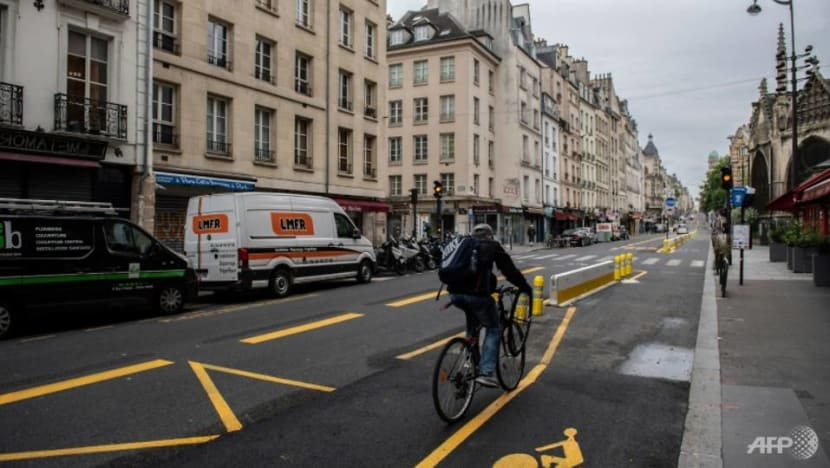commentary Commentary
Commentary: COVID-19 has made cities cleaner, quieter and healthier
From the decline of fossil fuel-powered vehicles to the rise of green buildings and shared spaces, Lord Norman Foster shares his view on what lies ahead for cities post-pandemic.

File photo of a dedicated cycling lane on Tanah Merah Coast Road. (Photo: Elizabeth Neo)
LONDON: If we could transport ourselves back to the last major global pandemic, the Spanish Flu of 1918 to 1920, we would find deserted city centres, curfews and quarantines.
But a century ago, the pandemic gave way to the social revolution of the Roaring Twenties – or Les Annees Folles. The future for humanity then was not two-metre social distancing any more than it will be for us.
Nonetheless, it’s worth asking: How will cities survive the current crisis; and how will they be different?
In the short term, it might seem as if everything is in flux, but looking further forward I believe we will see that the pandemic has simply accelerated trends that were already evident.
READ: Commentary: Is housing still affordable for first-time homeowners?
READ: Commentary: Bike lanes and housing in the CBD? Here’s how COVID-19 could transform cities
CITIES TRANSFORM WITH CRISES
The first and dominant trend is the power of the city as a social magnet. That collective energy creates wealth and opportunity – the gross domestic product of New York City, for example, is four times that of Switzerland.
There is also a statistical relationship in terms of greater life expectancy, lower infant mortality, and higher levels of education.
History tells us that cities are often transformed in response to crises. The Great Fire of London resulted in building codes that created the DNA of the elegant Georgian city; the response to the London cholera epidemic of the mid-19th century was a new city-wide sanitation system.
In the same century, health concerns saw the rise of public parks and gardens. Closer to our time, the smoggy conditions of London and Los Angeles in the 1950s and 1970s created Clean Air Acts.
You might argue that each of those developments would have happened independently, but there is no doubt that crises hastened the inevitable.
In a time of climate change and decarbonisation, the changing nature of mobility is another significant trend.
We are already witnessing a move away from fossil fuel-powered vehicles to those that use electric propulsion that can charge by induction while on the move.

When driverless, these vehicles will be able to park densely and safely, platooning nose-to-tail. All of this is happening at a time when younger generations are eschewing car ownership and embracing ride sharing and on-demand services, available at the touch of an app.
Trends in mobility cannot be separated from changes in the patterns of work and the nature of the workplace. Working at home was, for a fortunate few, always an option.
While the pandemic has prompted an upsurge in home working, it has also spurred the rise of the “third place”, whether that’s a Starbucks on the High Street, or a rural retreat.
And while “Zoom-ing” into conferences has stretched technology beyond expectations, it has also made us aware of the innate need to come together creatively and socially in shared spaces.
READ: Commentary: Does Singapore just have too many F&B outlets?
READ: Commentary: Why shopping hours in some Orchard Road malls and retailers are changing
CLEANER, QUIETER, HEALTHIER CITIES
Progressive designs for the workplace have always blurred the edges between work and leisure in pursuit of a better life balance. The term “green building” embraces a sustainable approach that has been proven to be healthier and more productive.
Until recently, those who championed green buildings have been on the enlightened fringe. But soon the concept will become mainstream, especially given a younger, more health-conscious workforce.
These topics have been the subject of workshops at the Norman Foster Foundation in Madrid, to encourage young graduates, who might one day be civic leaders, to anticipate the future.

But I have detected something new and that is attitude. This is evident in some bold initiatives taken during the pandemic, such as the creation of 650km of cycle lanes in Paris. It is also manifest in London, where streets in Soho have been commandeered by outdoor cafes.
Neighbourhoods outside the city core have also seen a resurgence in appeal. Tagged the “15-minute city”, these are places where working, learning, dining and recreation can all happen within walking distance from home.
Again, this is not new, but it has been boosted by the pandemic. Taken together, these trends add up to cities that can be cleaner, quieter, healthier, more walkable and bikeable, and vitally, greener.
READ: Commentary: Errant cycling gives the rest of us cyclists a bad name
READ: Commentary: The awkward adventures of a Singaporean urbanite in a city in nature
TOWARDS MORE EQUITABLE CITIES
Debates about the city often ignore those who make it function behind the scenes – essential workers in health services, cleaning, maintenance, sanitation and security.
A key consequence of change should be greater reward and better housing for this vital sector of society – in other words, a more equitable city.
Change is also linked to the rate of urbanisation. Before the pandemic, the equivalent of eight cities the size of New York were emerging annually around the world. All of this adds up to another 2.5 billion people living in cities in 30 years’ time.
READ: Commentary: Keeping public housing in prime locations like Greater Southern Waterfront affordable and fair
Looking further afield, could the impact of the pandemic lead to a reassessment of global networks and supply chains?
Politically, will it lead to more global collaboration on the big issues, such as energy production and climate change, or will we see more fragmentation and a shift towards an “everyone for themselves” approach?
The hope is that it will be “we, we, we” and not “me, me, me”. The ideal outcome is global action on the big environmental and health issues, and local action in all the activities such as governing and improving our connected societies.
Lord Norman Foster is the Founder and Executive Chairman of Foster + Partners. This is an edited version of the article published in the June 2021 issue of Urban Solutions magazine to be launched at the World Cities Summit 2021.














